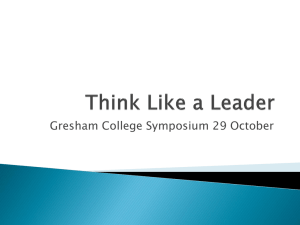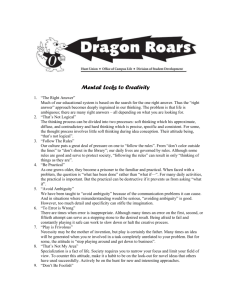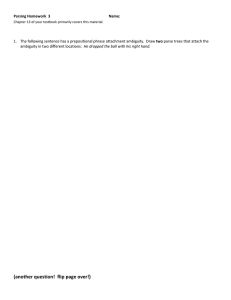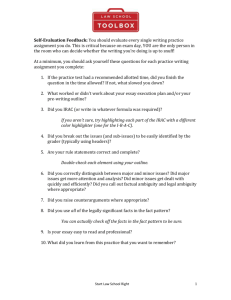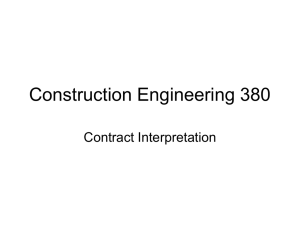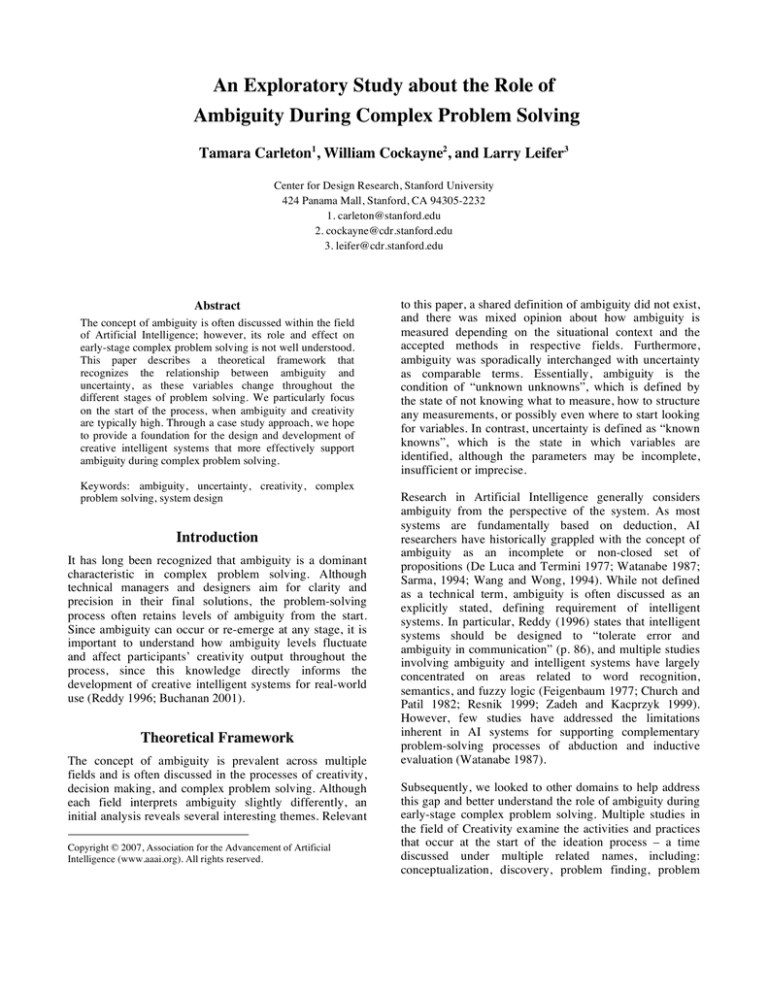
An Exploratory Study about the Role of
Ambiguity During Complex Problem Solving
Tamara Carleton1, William Cockayne2, and Larry Leifer3
Center for Design Research, Stanford University
424 Panama Mall, Stanford, CA 94305-2232
1. carleton@stanford.edu
2. cockayne@cdr.stanford.edu
3. leifer@cdr.stanford.edu
Abstract
The concept of ambiguity is often discussed within the field
of Artificial Intelligence; however, its role and effect on
early-stage complex problem solving is not well understood.
This paper describes a theoretical framework that
recognizes the relationship between ambiguity and
uncertainty, as these variables change throughout the
different stages of problem solving. We particularly focus
on the start of the process, when ambiguity and creativity
are typically high. Through a case study approach, we hope
to provide a foundation for the design and development of
creative intelligent systems that more effectively support
ambiguity during complex problem solving.
Keywords: ambiguity, uncertainty, creativity, complex
problem solving, system design
Introduction
It has long been recognized that ambiguity is a dominant
characteristic in complex problem solving. Although
technical managers and designers aim for clarity and
precision in their final solutions, the problem-solving
process often retains levels of ambiguity from the start.
Since ambiguity can occur or re-emerge at any stage, it is
important to understand how ambiguity levels fluctuate
and affect participants’ creativity output throughout the
process, since this knowledge directly informs the
development of creative intelligent systems for real-world
use (Reddy 1996; Buchanan 2001).
Theoretical Framework
The concept of ambiguity is prevalent across multiple
fields and is often discussed in the processes of creativity,
decision making, and complex problem solving. Although
each field interprets ambiguity slightly differently, an
initial analysis reveals several interesting themes. Relevant
Copyright © 2007, Association for the Advancement of Artificial
Intelligence (www.aaai.org). All rights reserved.
to this paper, a shared definition of ambiguity did not exist,
and there was mixed opinion about how ambiguity is
measured depending on the situational context and the
accepted methods in respective fields. Furthermore,
ambiguity was sporadically interchanged with uncertainty
as comparable terms. Essentially, ambiguity is the
condition of “unknown unknowns”, which is defined by
the state of not knowing what to measure, how to structure
any measurements, or possibly even where to start looking
for variables. In contrast, uncertainty is defined as “known
knowns”, which is the state in which variables are
identified, although the parameters may be incomplete,
insufficient or imprecise.
Research in Artificial Intelligence generally considers
ambiguity from the perspective of the system. As most
systems are fundamentally based on deduction, AI
researchers have historically grappled with the concept of
ambiguity as an incomplete or non-closed set of
propositions (De Luca and Termini 1977; Watanabe 1987;
Sarma, 1994; Wang and Wong, 1994). While not defined
as a technical term, ambiguity is often discussed as an
explicitly stated, defining requirement of intelligent
systems. In particular, Reddy (1996) states that intelligent
systems should be designed to “tolerate error and
ambiguity in communication” (p. 86), and multiple studies
involving ambiguity and intelligent systems have largely
concentrated on areas related to word recognition,
semantics, and fuzzy logic (Feigenbaum 1977; Church and
Patil 1982; Resnik 1999; Zadeh and Kacprzyk 1999).
However, few studies have addressed the limitations
inherent in AI systems for supporting complementary
problem-solving processes of abduction and inductive
evaluation (Watanabe 1987).
Subsequently, we looked to other domains to help address
this gap and better understand the role of ambiguity during
early-stage complex problem solving. Multiple studies in
the field of Creativity examine the activities and practices
that occur at the start of the ideation process – a time
discussed under multiple related names, including:
conceptualization, discovery, problem finding, problem
forming, problem framing, pre-inventive, pre-ideas, idea
formation, need-finding, and incipient innovation (McKim
1972; Simon 1995; Finke, Ward, and Smith 1992; Amabile
1996; Sternberg 1999; Adams 2001; Lubart 2001;
Cockayne 2004). Although ambiguity was often noted as a
key characteristic of the creative process, there was limited
analysis of the strategies employed by individuals or teams
to handle ambiguity, especially in relation to complex
problems.
Related studies in the fields of Product Design and
Communication show that teams often actively use
ambiguity to negotiate intended meaning, notably as
problems are identified and further refined (Festinger
1962; McLuhan 1967; Schön 1983; Minneman 1991;
Simonin 1999; Stacey and Eckert 2003; von Stamm 2003;
Aoki and Woodruff 2005; Cross 2006). Broadly speaking,
ambiguity is regarded as a positive and active element in a
group process. In addition, the notion of complex problems
regularly surfaces in Design studies and was originally
characterized in the 1960s as “wicked problems” since
these problems were considered fundamentally intractable
(Rittel and Webber 1973).
They stipulate that problem solvers deliberately choose the
levels of uncertainty and ambiguity based on the process
and situation. Specifically, people use mental models to
approach and solve problems. When ambiguity is high,
problem solvers “must find or create an appropriate model
as part of the problem-solving process” (p. 77), which then
helps determine the requisite tasks, inputs, and desired
outcomes. Schrader, Riggs, and Smith developed an
Uncertainty-Ambiguity Matrix to show how problem
solvers approach different stages of the same problem
along the axes of uncertainty and ambiguity, which is
reproduced in Figure 1. Decisions are made based on three
key factors: (a) prior problem-solving experiences, (b)
organizational context, and (c) available resources. They
discuss sixteen propositions for determining a person’s
response to uncertainty and ambiguity throughout the
problem-solving process using these factors.
Management Studies provided the remaining data in our
literature review. In a seminal piece, Schrader, Riggs, and
Smith (1993) define ambiguity during times of technical
problem framing and solving in a business framework.
They characterize uncertainty as a lack of information and
ambiguity as a lack of clarity about a problem at hand.
Ambiguity is perceived in regard to the relationship
between the variables and the problem-solving algorithm.
As they explain:
The set of assumed relationships between variables
reflects the problem solver’s understanding of the
structure of the problem. The problem-solving
algorithm relates to how this understanding is to be
used for problem solving. (p. 78)
Two levels of ambiguity are defined based on the variables
and functional relationships involved:
Uncertainty. Characteristic of a situation in which the
problem solver considers the structure of the problem
(including the set of relevant variables) as given, but
is dissatisfied with his or her knowledge of the value
of these variables. (p. 77)
Ambiguity level 1. Characteristic of a situation in
which the problem solver considers the set of
potentially relevant variables as given. The
relationships between the variables and the problemsolving algorithm are perceived as in need of
determination. (p. 77)
Ambiguity level 2. Characteristic of a situation in
which the set of relevant variables as well as their
functional relationship and the problem-solving
algorithm are seen as in need of determination. (p. 78)
Figure 1. Uncertainty-Ambiguity Matrix
(Schrader, Riggs, and Smith 1993)
Methodology
Our research into ambiguity began at Stanford University
as part of industry-sponsored design research in the late
1980s (Minneman 1991). This research program,
conducted in conjunction with the award-winning course
ME 310 Design Entrepreneurship, has been run with the
mantra “Preserve Ambiguity,” a concept that been adopted
by additional design and innovation programs across the
university and abroad. This applied understanding of
ambiguity laid the general foundation for our methodology.
As a continuation of this research program, we conducted a
multi-day workshop in India. Our sample (n=28) was
comprised of senior engineering research managers
working with technology and manufacturing companies in
India. Each of the companies is considered a leader in its
respective industry, delivering an array of complex
products – including tractors, industrial pump systems,
home appliances, turbines, power generators, pressure and
temperature instruments, and automobiles – for Indian and
international markets. Over a third of the subjects lead
global product teams and have spent extensive time outside
of India for schooling and work, so they had a broad
international perspective.
Our objective was to explore how technical managers
approach early-stage complex problems that begin with
high levels of ambiguity. The workshop theme was
“movement in megacities in 2025”, which offered an openended, complex framework in a controlled setting. This
theme was selected because India currently has two of the
top five megacities in the world, ensuring that our sample
had a baseline familiarity with the issues inherent in
megacities.
The participants, all male and mid-aged, were grouped into
seven teams. Each team selected members based on
company alliances or similar interests, and teams choose
their own topics based on the workshop theme, such as the
complex problem of transporting farm goods into
megacities or the problem of household water supply,
delivery, availability, use, and re-use in the future. By
starting with both organizational and topical self-selection,
our goal was to remove early sources of conflict and focus
participant energy on collaboration and problem solving.
Complex Problem-Solving Process
While self-defined topics were different across teams, the
problem-solving process was consistent. All participants
were taught six distinctive critical thinking models during
the first two days and encouraged to apply these models
throughout the workshop. These models were selected
from methods used extensively in Stanford engineering
undergraduate and graduate courses and corporate
workshops (Cockayne 2007). These methods are briefly
summarized below.
A. S-curve analysis. A graphical representation to explain
the progression of changes in terms of technological,
social, and other related filters.
B. Janus cones. A foresight framework for looking
backwards and forwards in time to identify the timing of
historical events and how these timings affect similar
future events within an opportunity space.
C. Daisygram. A mapping technique for capturing
emergent conversation themes in complex problems.
D. Design skit. A short theatrical performance to illustrate
a particular user need or design benefit.
E. 3-D paper prototyping. A design method to build and
communicate a product concept in three-dimensional space
by using paper and other inexpensive materials.
F. Dark horse prototyping. A design method to build and
communicate a product concept that is considered high risk
and/or least likely to succeed.
We designed the workshop to take participants on a
journey from high to low ambiguity in three distinct
phases: Foresight, Research, and Design. This plan allowed
participants to become more comfortable with ambiguity
as a precursor to being creative. During the Foresight
phase, participants used the first three methods (A, B, C) to
decide how best to approach their workshop topic, with
teams choosing their own preferred mix of prescribed
methods. During the Research phase, participants gathered
data from credible sources and reworked their problem
solving models to either update earlier thinking or to better
present newly collected data (A, B, C). Finally, during the
Design phase, teams used each of the last three methods
(D, E, F) to bring their topics to life, and after hearing from
each other, they iterated prototypes and often chose to
update earlier models again (A, B, C). Team presentations
occurred once at the end of the Foresight phase, once at the
end of the Research phase, and twice during the Design
phase. The last presentation segued into group reflections
and learnings from the overall problem-solving process.
All presentations and workshop instructions were recorded,
and every team artifact and prototype built was
photographed. Feedback was solicited from participants
throughout the process via multiple informal interviews. In
addition, several senior faculty and advanced graduate
students served as participant-observers and provided
additional feedback and notes.
Discussion
With these results, we initially applied the theoretical
framework from Schrader, Riggs, and Smith, since it
offered the most pertinent description of ambiguity in a
problem-solving context. We can confirm the change from
high to moderate ambiguity throughout the workshop as a
determinant of the participants’ perceived ability to solve
complex problems. Most telling, overall team moods were
tense during the first two presentations, since participants
did not know which variables to identify, how these
variables might fit the problem solving models provided,
and what the underlying problem structure entailed. This
feeling of tension was palpable and was recorded through
self-reporting and observation. By the final presentations,
teams ultimately reported high satisfaction with the process
and the outcome, even remembering their earlier bouts of
frustration as a valuable part of the learning.
Analysis of Related Propositions
Using the Uncertainty-Ambiguity Matrix from Schrader,
Riggs, and Smith, we focused on the three categories
underlying their multiple propositions. These categories
describe the factors affecting how people handle ambiguity
during problem solving: (a) prior problem-solving
experiences, (b) organizational context, and (c) available
resources, and according to Schrader, Riggs, and Smith,
the combination of these factors indicates a strong
tolerance for situations of high ambiguity. Our analysis
pertains to the workshop and was informed primarily
through user-reported data, participant observations, and
team artifacts.
Prior problem-solving experiences. As we observed,
daily life in India is filled with ambiguity, leading to the
development of high levels of tolerance. At the same time,
the educational system instills exemplary analytical
thinking and problem-solving skills, and as one participant
noted: “In India, we are taught to remove ambiguity”.
These two capabilities for dealing with street life chaos and
workplace order are often described as being diametrically
opposed and irreconcilable; however, all participants
proved this assumption to be false. In addition, many
participants had prior experience living in megacities and
facing open-ended problems in industry, but they had little
knowledge about specific problem-solving models to use
during periods of high ambiguity. Since they did not
typically address long-term issues (beyond five years into
the future) in their work, they were initially uncomfortable
looking beyond that timeframe, and this factor contributed
to high levels of ambiguity within the workshop. Based on
the strong results delivered by each team and the positive
experience reported at the end of the workshop by all of
the participants, we surmise that they will likely approach
future problems containing high ambiguity with much
greater willingness and ability.
Organizational context. The workshop was conducted in
a controlled setting that proved favorable for exploring the
second proposition category of organizational context. The
offsite location away from corporate offices helped to
enhance team creativity and remove daily organizational
constraints. Participants felt empowered to think creatively
since their respective companies supported their
participation in the workshop. Participants also chose to
retain their corporate connections and requested colleagues
as teammates. This decision helped to manage ambiguity,
since participants gained a shared enterprise language and
common project experiences within each team. We believe
that participants preferred to maintain organizational roles
as a way to cope with ambiguity and solve problems
together using familiar algorithms. It also allowed them to
take their insights back to each company as a common
experience. We suggest additional research to investigate
the effect of organizational roles that either help reduce or
preserve ambiguity during early-stage problem solving.
Available resources. Turning to the third proposition
category, resources were readily available in terms of
information, expertise, and personal character. An onsite
library and internet access provided access to information
during the Research phase, although participants expressed
initial uncertainty with new data sources outside their
immediate industry area. In addition, the instructors served
as process experts throughout the workshop exercises,
which helped to reassure participants. Schrader, Riggs, and
Smith noted that the availability of “non-solution-specific
resources and skills”, such as money or time, is a
prerequisite for pursuing more novel approaches (p. 88).
We applied this principle during prototyping, encouraging
liberal use of available materials, and results from each
team exhibited high levels of novelty and creativity. Lastly,
we found support that some participants personally
embraced change more easily than others, and their
positive attitude and open mindedness helped to influence
those around them.
Extending the Uncertainty-Ambiguity Matrix
While the general propositions proved true in our study, we
encountered several challenges applying the UncertaintyAmbiguity Matrix. We recommend several changes to
extend this model for greater application for complex
problem solving.
Ambiguity before uncertainty. We did not see instances
that combined low uncertainty and high ambiguity about
the same problem. Until general ambiguity was reduced to
a level at which key variables began to emerge, teams did
not have the ability to pursue even questions with high
uncertainty. Ambiguity continued to exist throughout the
life of the problem, as teams converged on an optimal
solution, as shown in Figure 2. This two-step process –
first ambiguity, then uncertainty – is further supported
from our earlier studies. In addition, our findings did not
support two separate levels of high ambiguity since
participants’ understanding of variables frequently changed
during periods of high ambiguity. For example, while some
participants felt they understood which variables were
sufficiently important at the start of the problem, they
revised their assumptions as they gained more information
during the next phase.
Measuring ambiguity over time. While the UncertaintyAmbiguity Matrix helps compare key characteristics of
static ambiguity, it does not show the ebb and flow in
ambiguity during the development and life of a problem.
Instead of a 2x2 matrix, we propose using a graph as
illustrated in Figure 2, where time is represented along the
x-axis. This format is being tested as a way to record
fluctuating levels of ambiguity over time and better
understand the early stages in problem solving.
Ambiguity curve. Our data showed a clear change in
ambiguity, where there was an overall reduction from high
to low throughout the workshop. The change in ambiguity
is noted by an Ambiguity Curve in Figure 2, and this curve
could change based on the nature of the problem
(Cockayne and Carleton 2008). In practice, the curve is not
this tidy, since multiple mini-iterations may occur along
this path as smaller questions arise and are then solved by a
team as they address the greater context of a problem.
Problem finding and defining. Problem solving is often
approached as an undifferentiated process without
additional steps or sub-processes. In our case, the highest
levels of ambiguity occurred at the beginning of the entire
process, when each complex problem was highly
undefined. This time correlates with early-stage creativity,
when problem finding and problem defining are
recognized as common activities preceding problem
solving. These early stages can be added to the timeline to
show additional development from pre-concept to solution,
as shown in Figure 2. We also overlaid the three phases of
Foresight, Research and Design from the workshop, which
participants understood as recognized industry practices for
innovation and are often highly segregated within most
organizations. While drawn as separate phases, in practice
there is evident overlap between each phase.
Human creativity relies on organized patterns of
information and experience, which raises challenges for AI
system designs. Many systems today can handle increasing
uncertainty at the data level; however, it is incumbent on
the system designer (or user) to correctly predetermine the
context, boundary and goal of the problem. Correctly
designing for ambiguity remains an obstacle for AI, and
system designers are becoming further aware of the limits
of creative intelligent systems, when ambiguity about the
problem at hand persists – and may potentially need to be
preserved within the data as ideas are iterated and refined.
As the field of AI continues to address complex problem
solving, we feel that one of the next hurdles will be to
effectively support early-stage activities and extend human
capabilities in new areas by recognizing the role ambiguity
plays in human cognition. Potential applications for
creative intelligent systems may include finding more
original and novel ways for resolving ambiguity earlier,
providing additional models to more effectively facilitate
problem finding and problem defining when ambiguity is
high, and augmenting early-stage team activities to either
reduce ambiguity more rapidly or manage ambiguity more
comfortably.
Further Research
Several limitations exist in our study. First, our sample is
small and biased. The workshop participants provided a
convenience sample and were not selected to represent
normal problem solvers. All participants are highly
accomplished in senior roles and were sponsored by their
companies based on their prior work in engineering
innovation, which leads us to believe that each person had
a recognized aptitude for change and strong skills in
complex problem solving. Moreover, while we did not
directly observe any cultural factors from Indian business
that influenced team interactions and problem-solving
approaches, additional research might examine how
different cultures perceive ambiguity and its effect on
complex problem solving and creativity.
Figure 2. A Broader Spectrum of Complex Problem Solving
Implications for Creative Intelligent Systems
According to Buchanan (2001), the AI community has
developed a strong handle on heuristic search with respect
to problem-solving models, as well as gained an increased
understanding of creativity models and substantial more
computing power within recent years. Using the extended
framework proposed here, creative intelligent systems
should be capable of supporting both ambiguity and
uncertainty throughout the different stages of complex
problem solving. When new thinking or new models of
thinking are needed, additional or better sources of
creativity becomes essential to advance between the stages.
In addition, the scope of the study was exploratory, so
significant research is needed to further investigate the role
of ambiguity in creative intelligent systems and other
industrial applications, including design and innovation.
Additional studies could examine how ambiguity levels
change, as groups refine their problem solving methods
over more extended timeframes. We recognize that this
study may raise more questions than it addresses, and we
hope it contributes to the broader discussion about the role
of ambiguity in complex problem solving and creativity
support tools.
References
Adams, J. L. 2001. Conceptual Blockbusting: A Guide to Better
Ideas. Cambridge, Mass.: Perseus Publications.
Aoki P. M. and Woodruff, A. 2005. Making Space for Stories:
Ambiguity in the Design of Personal Communication Systems.
Proc. CHI 2005: 181-190.
Amabile, T. 1996. Creativity in Context. Boulder, Colo.:
Westview Press.
Buchanan, B. G. 2001. Creativity at the Metalevel: AAAI-2000
Presidential Address. AI Magazine 22(3): 13-28.
Resnik, P. 1999. Semantic Similarity in a Taxonomy: An
InformationBased Measure and its Application to Problems of
Ambiguity in Natural Language. Journal of Artificial Intelligence
Research, 11: 95-130.
Rittel, H and Webber, M. 1973. Dilemmas in a General Theory of
Planning. Policy Sciences 4: 155-169.
Sarma, V. V. S. 1994. Decision Making in Complex Systems.
Journal Systemic Practice and Action Research 7(4): 399-407.
Church, K., and Patil, R. 1982. Coping With Syntactic Ambiguity
or How to Put the Block in the Box on the Table. Computational
Linguistics 8(3-4): 139-149.
Schön, .D. A. 1983. The Reflective Practitioner: How
Professionals Think in Action. New York: Basic Books.
Cockayne, W. 2004. A Study of the Formation of Innovation
Ideas in Informal Networks. Ph.D. diss., Dept. of Mechanical
Engineering, Stanford Univ., Stanford, Calif.
Schrader, S.; Riggs, W.; and Smith, R. 1993. Choice Over
Uncertainty and Ambiguity in Technical Problem Solving.
Journal of Engineering and Technology Management 10: 73-99.
Cockayne, W. 2007. Personal communication.
Simon, H. 1995. Problem Forming, Problem Finding, and
Problem Solving in Design. In A. Collen and W. Gasparski eds.
Design & Systems: General Applications of Methodology. New
Brunswick, NJ: Transaction Publishers.
Cockayne, W. and Carleton, T. 2008. Foresight to Innovation.
Forthcoming.
Cross, N. 2006. Designerly Ways of Knowing. London: Springer.
De Luca, A. and Termini, S. 1977. Measures of Ambiguity in the
Analysis of Complex Systems. Lecture Notes in Computer
Science 53: 382-389.
Feigenbaum, E. A. 1977. The Art of Artificial Intelligence: I.
Themes and Case Studies of Knowledge Engineering. Technical
Report, STAN-CS-77-621, Dept. of Computer Science, Stanford
Univ.
Finke, R. A.; Ward, T. B.; and Smith, S. M. 1992. Creative
Cognition: Theory, Research and Applications. Cambridge,
Mass.: MIT Press.
Festinger, L. 1962. A Theory of Cognitive Dissonance. Stanford,
Calif.: Stanford University Press.
Lubart, T. I. 2001. Models of the Creative Process: Past, Present
and Future. Creativity Research Journal 13(3&4): 295–308.
McKim, R. 1972. Experiences in Visual Thinking. Monterey,
Calif., Brooks/Cole Pub. Co.
McLuhan, M. and Fiore, Q. 1967. The Medium Is the Massage.
New York: Random House.
Minneman, S. L. 1991. The Social Construction of a Technical
Reality: Empirical Studies of Group Engineering Design Practice.
Ph.D. diss., Dept. of Mechanical Engineering, Stanford Univ.,
Stanford, Calif.
Reddy, R. 1996. The Challenge of Artificial Intelligence. IEEE
Computer 29(10): 86-98.
Simonin, B. 1999. Ambiguity and the Process of Knowledge
Transfer in Strategic Alliances. Strategic Management Journal
20(7): 595-623.
Stacey, M. and Eckert, C. 2003. Against Ambiguity. Computer
Supported Cooperative Work 12: 153–183
Sternberg, R. 1999. Handbook of Creativity. Cambridge:
Cambridge University Press.
von Stamm, B. 2005. Managing Innovation, Design and
Creativity. London: John Wiley & Sons.
Wang, Z. W. and Wong, S. K. M. (1994). A Global Measure of
Ambiguity for Classification. In Methodologies for Intelligent
Systems. Berlin, Germany: Springer.
Watanabe, S. 1987. Inductive Ambiguity and the Limits of
Artificial Intelligence, Computational Intelligence 3(1), 304–309.
Zadeh, L. A. and Kacprzyk, J. 1999. Computing with Words in
Information/Intelligent Systems 1. Berlin, Germany: Springer.

